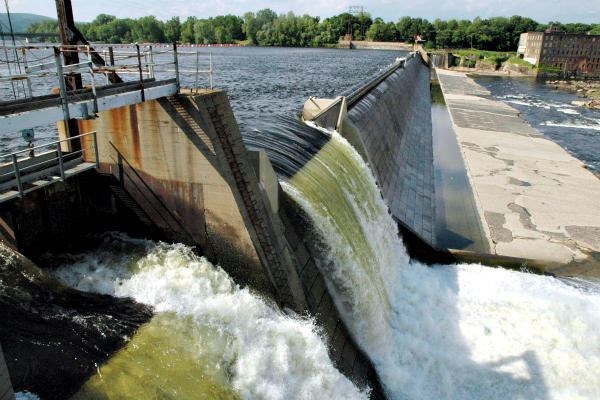On Sept. 29 thousands of volunteers will spread out along the banks of the Connecticut River collecting tons of plastic bottles, cans, food containers, and other trash.

|
| Water spills over the Holyoke Dam, a hydroelectric dam on the Connecticut River in Holyoke, Mass. On Sept. 29 volunteers will scatter along the more than 400-mile river, which runs through four New England states, to pick up bottles, cans, and other trash. John Nordell/The Christian Science Monitor/File |
It's time for New England's longest river to come clean.
The dry summer and low water levels exposed thousands of plastic bottles, cans, and food containers along the 407-mile long Connecticut River. However, after annual "Source to Sea Cleanup" sponsored by the Connecticut River Watershed Council (CRWC), the waters will be running a little cleaner.
On Sept. 29 thousands of volunteers are expected to fan out across the 11,000-square-miles of the Connecticut River watershed.
This year the cleanup has an international flavor. TransCanada Corporation, based in Calgary, Alberta, but operating hydropower plants throughout New England, is a lead sponsor. It's also the first year Source to Sea will be registered under the umbrella of the Ocean Conservancy's International Coastal Cleanup (ICC), considered the largest one-day volunteer effort to haul trash from streams, rivers, and oceans.
This kind of involvement is important because it "gives the cleanup context," says Andrew Fisk, executive director of the CRWC, a nonprofit organization based in Greenfield, Mass.
Volunteers work individually or in groups. Clubs and businesses form groups too. People of all ages and abilities are encouraged to join the effort, on foot or by boat. They will clean the river itself or one of its historic tributaries, Mr. Fisk says.
If people don't want to scoop up Styrofoam themselves, they may donate supplies or sponsor a group, Fisk says.
"We have Brownie troops and volunteer firefighters. We have large groups and small groups, each of them responsible for 200 to 300 yards of river. Smaller groups cover even less ground. So registering with ICC helps people understand they are part of something bigger," Fisk says.
TransCanada donated $10,000 to the cleanup effort because it operates several hydropower projects throughout the northeast. The Connecticut, New England's largest and longest river, starts flowing from Fourth Connecticut Lake in New Hampshire, just 300 yards from the Canadian border. It eventually defines the border between Vermont and New Hampshire, crosses central Massachusetts, and pours into the sea on the Connecticut coast.
"We stepped up our sponsorship this year because we feel the health of the Connecticut River is very important," says Matthew Cole, community relations specialist for TransCanada Hydro Northeast.
The watershed council wants volunteers to track the trash they find.
"We use this information to advocate for policy," Fisk says. "If you are making product stewardship laws, whether it's bottle bills or deposits on tires, [the information] helps inform policy decisions. We can see whether we should be doing something different."
For example, the CRWC will use the data gleaned from the cleanup to help support an expanded bottle-deposit bill in Massachusetts, Fisk says.
In the past 15 years people have pulled more than 707 tons of trash from New England's longest river, according to CRWC. Volunteers picked up 7,000 beverage containers in 2011, down from 12,000 in 2010, says CRWC cleanup coordinator Jacqueline Talbot.
"There are similar cleanups all over the world because, unfortunately, there is trash everywhere," Ms. Talbot says. "Inland debris pollution of rivers is a huge community problem, and we appreciate all cleanup efforts that bring attention to this issue as well as helping hands to our natural resources. Our effort, like all local efforts, is important because we are cleaning up our waters that contribute so much to our communities. "
In addition, the CRWC is asking residents in Vermont, New Hampshire, Massachusetts, and Connecticut to report trash sites. In 2010 a tip led cleanup crews to a massive illegal tire dump in Hadley, Mass.
Even without tips CRWC knows where to go.
"The way river hydrology works, there are places where stuff always collects," Fisk says.
Last year tropical storm Irene toppled numerous trees throughout Vermont and Massachusetts. Water flow remains partially blocked in places along the river and its watershed, creating conditions for large deposits of debris.
Some of TransCanada's hydro division storage reservoirs are still recovering from Irene. Last year workers filled 11 20-yard dumpsters with man-made debris, including insulation and plastic water bottles, Mr. Cole says.
Page created on 9/18/2012 12:00:00 AM
Last edited 9/18/2012 12:00:00 AM

